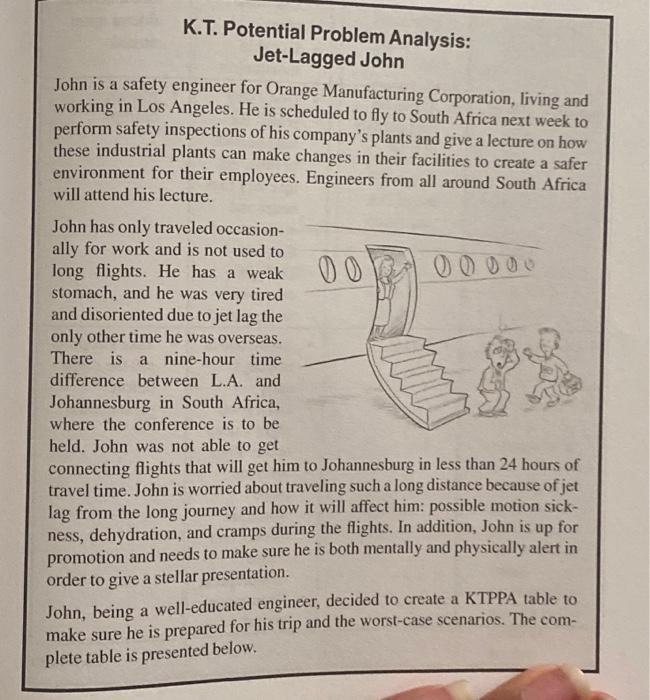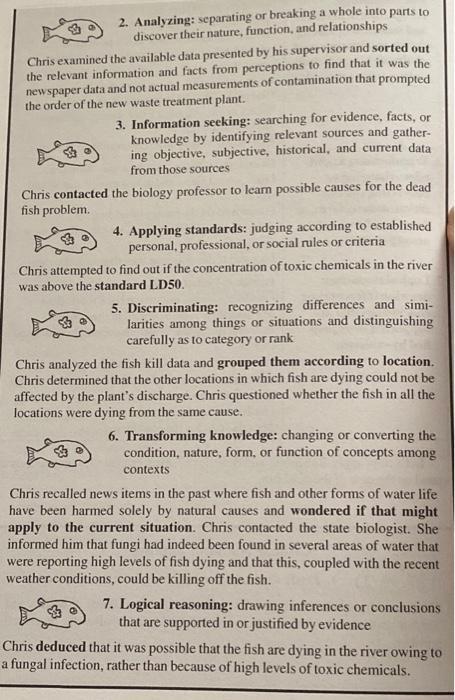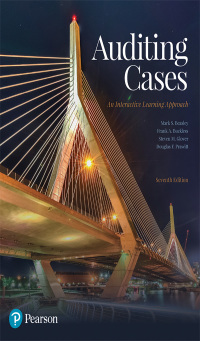Answered step by step
Verified Expert Solution
Question
1 Approved Answer
9.3. Prepare a follow-up checklist for each of these situations: A. K.T. Potential Problem Analysis: Jet-Lagged John (Chapter 8) B. The example regarding the




9.3. Prepare a follow-up checklist for each of these situations: A. "K.T. Potential Problem Analysis: Jet-Lagged John" (Chapter 8) B. The example regarding the dead fish in the river (Chapter 3) K.T. Potential Problem Analysis: Jet-Lagged John John is a safety engineer for Orange Manufacturing Corporation, living and working in Los Angeles. He is scheduled to fly to South Africa next week to perform safety inspections of his company's plants and give a lecture on how these industrial plants can make changes in their facilities to create a safer environment for their employees. Engineers from all around South Africa will attend his lecture. John has only traveled occasion- ally for work and is not used to long flights. He has a weak stomach, and he was very tired and disoriented due to jet lag the only other time he was overseas. There is a nine-hour time difference between L.A. and Johannesburg in South Africa, where the conference is to be held. John was not able to get connecting flights that will get him to Johannesburg in less than 24 hours of travel time. John is worried about traveling such a long distance because of jet lag from the long journey and how it will affect him: possible motion sick- ness, dehydration, and cramps during the flights. In addition, John is up for promotion and needs to make sure he is both mentally and physically alert in order to give a stellar presentation. John, being a well-educated engineer, decided to create a KTPPA table to make sure he is prepared for his trip and the worst-case scenarios. The com- plete table is presented below. Critical Thinking Actions 1. Predicting: envisioning a plan and its consequences Chris envisioned that the proposed plant would cost millions of dollars and wanted to make sure that such an expenditure would solve the perceived problem. 2. Analyzing: separating or breaking a whole into parts to discover their nature, function, and relationships Chris examined the available data presented by his supervisor and sorted out the relevant information and facts from perceptions to find that it was the newspaper data and not actual measurements of contamination that prompted the order of the new waste treatment plant. o 3. Information seeking: searching for evidence, facts, or knowledge by identifying relevant sources and gather- ing objective, subjective, historical, and current data from those sources Chris contacted the biology professor to learn possible causes for the dead fish problem. 4. Applying standards: judging according to established personal, professional, or social rules or criteria Chris attempted to find out if the concentration of toxic chemicals in the river was above the standard LD50. 5. Discriminating: recognizing differences and simi- larities among things or situations and distinguishing carefully as to category or rank Chris analyzed the fish kill data and grouped them according to location. Chris determined that the other locations in which fish are dying could not be affected by the plant's discharge. Chris questioned whether the fish in all the locations were dying from the same cause. 6. Transforming knowledge: changing or converting the condition, nature, form, or function of concepts among contexts Chris recalled news items in the past where fish and other forms of water life have been harmed solely by natural causes and wondered if that might apply to the current situation. Chris contacted the state biologist. She informed him that fungi had indeed been found in several areas of water that were reporting high levels of fish dying and that this, coupled with the recent weather conditions, could be killing off the fish. 7. Logical reasoning: drawing inferences or conclusions that are supported in or justified by evidence Chris deduced that it was possible that the fish are dying in the river owing to a fungal infection, rather than because of high levels of toxic chemicals. 9.3. Prepare a follow-up checklist for each of these situations: A. "K.T. Potential Problem Analysis: Jet-Lagged John" (Chapter 8) B. The example regarding the dead fish in the river (Chapter 3) K.T. Potential Problem Analysis: Jet-Lagged John John is a safety engineer for Orange Manufacturing Corporation, living and working in Los Angeles. He is scheduled to fly to South Africa next week to perform safety inspections of his company's plants and give a lecture on how these industrial plants can make changes in their facilities to create a safer environment for their employees. Engineers from all around South Africa will attend his lecture. John has only traveled occasion- ally for work and is not used to long flights. He has a weak stomach, and he was very tired and disoriented due to jet lag the only other time he was overseas. There is a nine-hour time difference between L.A. and Johannesburg in South Africa, where the conference is to be held. John was not able to get connecting flights that will get him to Johannesburg in less than 24 hours of travel time. John is worried about traveling such a long distance because of jet lag from the long journey and how it will affect him: possible motion sick- ness, dehydration, and cramps during the flights. In addition, John is up for promotion and needs to make sure he is both mentally and physically alert in order to give a stellar presentation. John, being a well-educated engineer, decided to create a KTPPA table to make sure he is prepared for his trip and the worst-case scenarios. The com- plete table is presented below. Critical Thinking Actions 1. Predicting: envisioning a plan and its consequences Chris envisioned that the proposed plant would cost millions of dollars and wanted to make sure that such an expenditure would solve the perceived problem. 2. Analyzing: separating or breaking a whole into parts to discover their nature, function, and relationships Chris examined the available data presented by his supervisor and sorted out the relevant information and facts from perceptions to find that it was the newspaper data and not actual measurements of contamination that prompted the order of the new waste treatment plant. o 3. Information seeking: searching for evidence, facts, or knowledge by identifying relevant sources and gather- ing objective, subjective, historical, and current data from those sources Chris contacted the biology professor to learn possible causes for the dead fish problem. 4. Applying standards: judging according to established personal, professional, or social rules or criteria Chris attempted to find out if the concentration of toxic chemicals in the river was above the standard LD50. 5. Discriminating: recognizing differences and simi- larities among things or situations and distinguishing carefully as to category or rank Chris analyzed the fish kill data and grouped them according to location. Chris determined that the other locations in which fish are dying could not be affected by the plant's discharge. Chris questioned whether the fish in all the locations were dying from the same cause. 6. Transforming knowledge: changing or converting the condition, nature, form, or function of concepts among contexts Chris recalled news items in the past where fish and other forms of water life have been harmed solely by natural causes and wondered if that might apply to the current situation. Chris contacted the state biologist. She informed him that fungi had indeed been found in several areas of water that were reporting high levels of fish dying and that this, coupled with the recent weather conditions, could be killing off the fish. 7. Logical reasoning: drawing inferences or conclusions that are supported in or justified by evidence Chris deduced that it was possible that the fish are dying in the river owing to a fungal infection, rather than because of high levels of toxic chemicals. 9.3. Prepare a follow-up checklist for each of these situations: A. "K.T. Potential Problem Analysis: Jet-Lagged John" (Chapter 8) B. The example regarding the dead fish in the river (Chapter 3) K.T. Potential Problem Analysis: Jet-Lagged John John is a safety engineer for Orange Manufacturing Corporation, living and working in Los Angeles. He is scheduled to fly to South Africa next week to perform safety inspections of his company's plants and give a lecture on how these industrial plants can make changes in their facilities to create a safer environment for their employees. Engineers from all around South Africa will attend his lecture. John has only traveled occasion- ally for work and is not used to long flights. He has a weak stomach, and he was very tired and disoriented due to jet lag the only other time he was overseas. There is a nine-hour time difference between L.A. and Johannesburg in South Africa, where the conference is to be held. John was not able to get connecting flights that will get him to Johannesburg in less than 24 hours of travel time. John is worried about traveling such a long distance because of jet lag from the long journey and how it will affect him: possible motion sick- ness, dehydration, and cramps during the flights. In addition, John is up for promotion and needs to make sure he is both mentally and physically alert in order to give a stellar presentation. John, being a well-educated engineer, decided to create a KTPPA table to make sure he is prepared for his trip and the worst-case scenarios. The com- plete table is presented below. Critical Thinking Actions 1. Predicting: envisioning a plan and its consequences Chris envisioned that the proposed plant would cost millions of dollars and wanted to make sure that such an expenditure would solve the perceived problem. 2. Analyzing: separating or breaking a whole into parts to discover their nature, function, and relationships Chris examined the available data presented by his supervisor and sorted out the relevant information and facts from perceptions to find that it was the newspaper data and not actual measurements of contamination that prompted the order of the new waste treatment plant. o 3. Information seeking: searching for evidence, facts, or knowledge by identifying relevant sources and gather- ing objective, subjective, historical, and current data from those sources Chris contacted the biology professor to learn possible causes for the dead fish problem. 4. Applying standards: judging according to established personal, professional, or social rules or criteria Chris attempted to find out if the concentration of toxic chemicals in the river was above the standard LD50. 5. Discriminating: recognizing differences and simi- larities among things or situations and distinguishing carefully as to category or rank Chris analyzed the fish kill data and grouped them according to location. Chris determined that the other locations in which fish are dying could not be affected by the plant's discharge. Chris questioned whether the fish in all the locations were dying from the same cause. 6. Transforming knowledge: changing or converting the condition, nature, form, or function of concepts among contexts Chris recalled news items in the past where fish and other forms of water life have been harmed solely by natural causes and wondered if that might apply to the current situation. Chris contacted the state biologist. She informed him that fungi had indeed been found in several areas of water that were reporting high levels of fish dying and that this, coupled with the recent weather conditions, could be killing off the fish. 7. Logical reasoning: drawing inferences or conclusions that are supported in or justified by evidence Chris deduced that it was possible that the fish are dying in the river owing to a fungal infection, rather than because of high levels of toxic chemicals. 9.3. Prepare a follow-up checklist for each of these situations: A. "K.T. Potential Problem Analysis: Jet-Lagged John" (Chapter 8) B. The example regarding the dead fish in the river (Chapter 3) K.T. Potential Problem Analysis: Jet-Lagged John John is a safety engineer for Orange Manufacturing Corporation, living and working in Los Angeles. He is scheduled to fly to South Africa next week to perform safety inspections of his company's plants and give a lecture on how these industrial plants can make changes in their facilities to create a safer environment for their employees. Engineers from all around South Africa will attend his lecture. John has only traveled occasion- ally for work and is not used to long flights. He has a weak stomach, and he was very tired and disoriented due to jet lag the only other time he was overseas. There is a nine-hour time difference between L.A. and Johannesburg in South Africa, where the conference is to be held. John was not able to get connecting flights that will get him to Johannesburg in less than 24 hours of travel time. John is worried about traveling such a long distance because of jet lag from the long journey and how it will affect him: possible motion sick- ness, dehydration, and cramps during the flights. In addition, John is up for promotion and needs to make sure he is both mentally and physically alert in order to give a stellar presentation. John, being a well-educated engineer, decided to create a KTPPA table to make sure he is prepared for his trip and the worst-case scenarios. The com- plete table is presented below. Critical Thinking Actions 1. Predicting: envisioning a plan and its consequences Chris envisioned that the proposed plant would cost millions of dollars and wanted to make sure that such an expenditure would solve the perceived problem. 2. Analyzing: separating or breaking a whole into parts to discover their nature, function, and relationships Chris examined the available data presented by his supervisor and sorted out the relevant information and facts from perceptions to find that it was the newspaper data and not actual measurements of contamination that prompted the order of the new waste treatment plant. o 3. Information seeking: searching for evidence, facts, or knowledge by identifying relevant sources and gather- ing objective, subjective, historical, and current data from those sources Chris contacted the biology professor to learn possible causes for the dead fish problem. 4. Applying standards: judging according to established personal, professional, or social rules or criteria Chris attempted to find out if the concentration of toxic chemicals in the river was above the standard LD50. 5. Discriminating: recognizing differences and simi- larities among things or situations and distinguishing carefully as to category or rank Chris analyzed the fish kill data and grouped them according to location. Chris determined that the other locations in which fish are dying could not be affected by the plant's discharge. Chris questioned whether the fish in all the locations were dying from the same cause. 6. Transforming knowledge: changing or converting the condition, nature, form, or function of concepts among contexts Chris recalled news items in the past where fish and other forms of water life have been harmed solely by natural causes and wondered if that might apply to the current situation. Chris contacted the state biologist. She informed him that fungi had indeed been found in several areas of water that were reporting high levels of fish dying and that this, coupled with the recent weather conditions, could be killing off the fish. 7. Logical reasoning: drawing inferences or conclusions that are supported in or justified by evidence Chris deduced that it was possible that the fish are dying in the river owing to a fungal infection, rather than because of high levels of toxic chemicals.
Step by Step Solution
There are 3 Steps involved in it
Step: 1
Followup Checklist for KT Potential Problem Analysis JetLagged John 1 Evaluate Travel Schedule Check the flight schedule and duration to ensure sufficient time for rest and acclimatization to the time ...
Get Instant Access to Expert-Tailored Solutions
See step-by-step solutions with expert insights and AI powered tools for academic success
Step: 2

Step: 3

Ace Your Homework with AI
Get the answers you need in no time with our AI-driven, step-by-step assistance
Get Started


